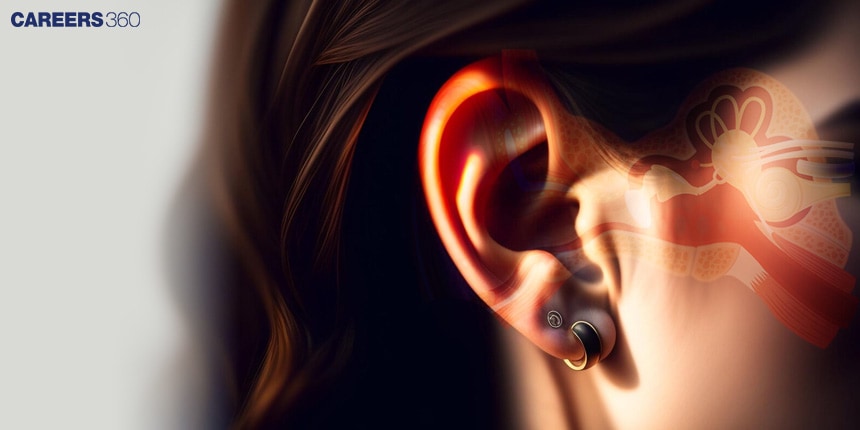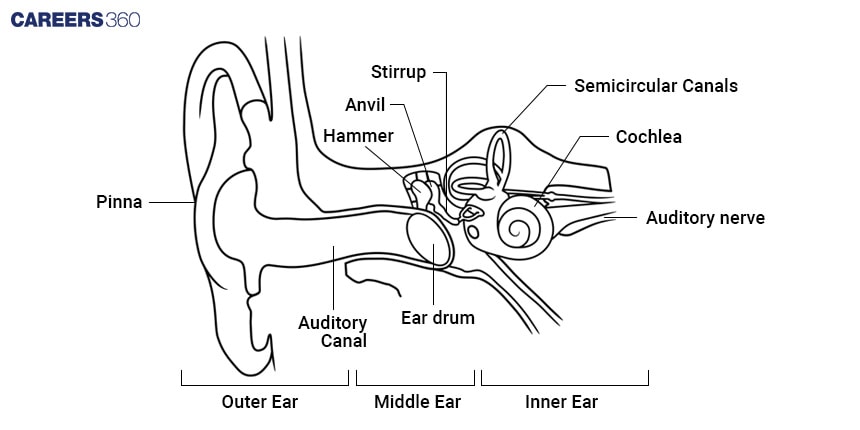Structure of Ear: Facts, Function, Parts
The ear has two major functions hearing and balance. It is composed of three parts the outer ear, which collects the sound; the middle ear, which amplifies sound through small bones and the inner ear, which converts it into signals to the brain. The inner ear contains the vestibular system, which helps in the control of balance. This is an important topic in biology, mainly for the NEET and AIIMS BSc Nursing exams where questions are asked from sensory systems.
NEET 2025: Mock Test Series | Syllabus | High Scoring Topics | PYQs
NEET Important PYQ's Subject wise: Physics | Chemistry | Biology
New: Meet Careers360 B.Tech/NEET Experts in your City | Book your Seat now
- Human Ear
- Anatomy of Ear
- Physiology of the Ear
- Hearing Mechanism
- Recommended Video on the Structure of Ear

Human Ear
The human ear consists of two functions hearing and balance. Three elements make up the human ear, the outer ear collects the sound, the middle ear amplifies it, and the inner ear translates it into electrical signals that are sent to the brain. The inner ear also contains structures associated with balance. Put simply, the human ear helps us hear and balance ourselves.
Also Read:
- Practice MCQ on the Mechanism of Hearing
- Neural Control and Coordination
- Diagram of Ear
- Chemical Coordination and Integration
Anatomy of Ear
The anatomy of the ear involves three regions that are closely related: the outer ear, the middle ear, and the inner ear.
Parts of the Outer Ear
Anatomy of the ear's outer or external parts includes the following:
Pinna
Small hairs and glands on the outermost part secrete sticky wax and will avoid the entry of foreign organisms and dust into the ear. It will receive the sound.
External Auditory Canal (Meatus)
Runs from the pinna to the tympanic membrane, packed with wax glands.
Tympanic Membrane
Made of connective tissue, it is covered on the outside by skin and is lined with a mucous membrane on the inside. This membrane separates the external ear from the middle ear.
Anatomy of the External Ear
The auricle is a thin plate of yellow elastic cartilage moulded into definite ridges furrows and depressions. The concha runs into the external auditory canal. It is also formed by the helix and antihelix.
The external auditory canal is a curved, s-shaped tube that extends up to the tympanic membrane. It is lined by skin, but the skin falls by being very thin and contains thin hair and wax-producing glands to keep it clear from the entry of foreign particles.
Pinna Function
The pinna is the organ of the auditory system responsible for gathering sound vibrations. Vibrations reach the pinna travel and, through and into the middle ear via the external auditory canal.
Middle Ear
The middle ear contains the following anatomy:
Ossicles
A chain of three tiny bones: malleus, incus, and stapes.
Malleus
The malleus is a bone shaped like a hammer fixed to the tympanic membrane.
Incus
A bone between them.
Stapes
This is the smallest bone among the human, and it is stirrup-shaped. This bone is connected to the oval window within the cochlea.
Eustachian Tube
It joins the middle ear and the pharynx. It balances the middle ear pressure with the external atmospheric pressure.
The pressure is amplified and directed by this into the inner ear. This is an air-filled cavity with a small space in it. It can be subdivided into the tympanum and epitympanum chambers.
Cavity of the Middle Ear
The middle ear space is an irregularly shaped cavity having four walls, a roof, and a floor.
The lateral wall is formed by the tympanic membrane.
Bone separating the cranial and middle ear cavities comprise the superior wall.
The inferior wall separates the middle ear from the jugular vein and carotid artery.
The posterior wall is separated from the mastoid antrum.
The anterior wall opens in the eustachian tube.
Structure of the Inner Ear
The inner ear structure consists of:
Bony Labyrinth
- A cavity (a bony channel in the temporal bone) is divided into the semicircular canals, the vestibule, and the cochlea.
- It contains the membranous labyrinth, which is full of the perilymph fluid.
- Endolymph fluid goes inside the membranous labyrinth.
Cochlea
- The auditory organ forms a spiral, snail-shaped portion consisting of three canals, which are, the scala vestibule, scala media, and scala tympani.
- Scala vestibule and scala tympani contain perilymph; however, scala media is filled with endolymph and contains the organ of Corti.
- The hair cells of the cochlea are sensitive to pressure waves and convert them into nerve impulses which are then sent to the brain.
Vestibular Apparatus (Equilibrium Organ)
- This apparatus is composed of two sac-like chambers, the saccule and utricle and three semicircular canals.
- The saccule and utricle are associated maculae consisting of hair cells, which are surrounded by ampullary cupula and otoliths.
- Semicircular canals are the endolymph filled. It opens into the utricle. The crista ampullaris in each ampulla knows the angular rotation.

Physiology of the Ear
It is the process through which the ear collects and processes sound and then transmits it to the brain. As a result of the entry of sound into the outer ear, it makes the eardrum vibrate. The vibrations are passed down to the ossicles in the middle ear, where they are amplified. The inner ear mainly consists of the cochlea, which changes the vibrations into electric signals that pass through the auditory nerve to the brain. The inner ear contains the vestibular system, which ensures balance.
Sound Collection: The pinna and ear canal collect sound into the outer ear.
Vibration Transmission: When sound waves reach the eardrum, they cause it to vibrate. These vibrations are transmitted through ossicles in the middle ear.
Sound Conversion: The cochlea in the inner ear converts vibrations into electrical signals.
Signal Transmission: The electrical signal is transmitted through the auditory nerve to the brain.
Balance Maintenance: The vestibular system, found in the human inner ear, is in charge of maintaining balance.
Hearing Mechanism
The hearing is brought by the organ of Corti (Cochlea). The mechanism is as follows:
The waves of sound are picked by the pinna.
These waves of sound vibrate the eardrum.
Now the vibrations are transferred to the ossicles.
The stapes transmit the vibrations to the perilymph in the cochlea.
The vibrations resonate with the basilar membrane and bend hair cell stereocilia.
The ion channels open, releasing neurotransmitters that continue a signal to the brain via the auditory nerve.
Mechanism of Maintaining Equilibrium
The vestibular apparatus maintains equilibrium.
Static Equilibrium is contained by maculae in the saccule and utricle with otoliths pressing on stereocilia.
Dynamic Equilibrium is felt by cristae in semicircular canals sensing the movement of fluid in canals.
Also Read:
| Mechanism of Hearing | Receptors |
| Disorders of Eye and Ear | Structure of the Human Eye |
| Mechanism of Vision | Neuron |
Recommended Video on the Structure of Ear
Frequently Asked Questions (FAQs)
The three significant configurations are the outer ear, middle ear, and inner ear.
The vestibular apparatus maintains balance and equilibrium of the body with saccule, utricle and semicircular canals comprising the vestibular apparatus.
The organ of Corti bearing the auditory receptors in the inner ear is located in the cochlea.
Hair cells are present in the organ of Corti within the cochlea.
There are three ossicles in the middle ear: malleus, incus, and stapes.
Also Read
30 Nov'24 10:55 AM
29 Nov'24 08:48 PM
29 Nov'24 06:52 PM
29 Nov'24 05:35 PM